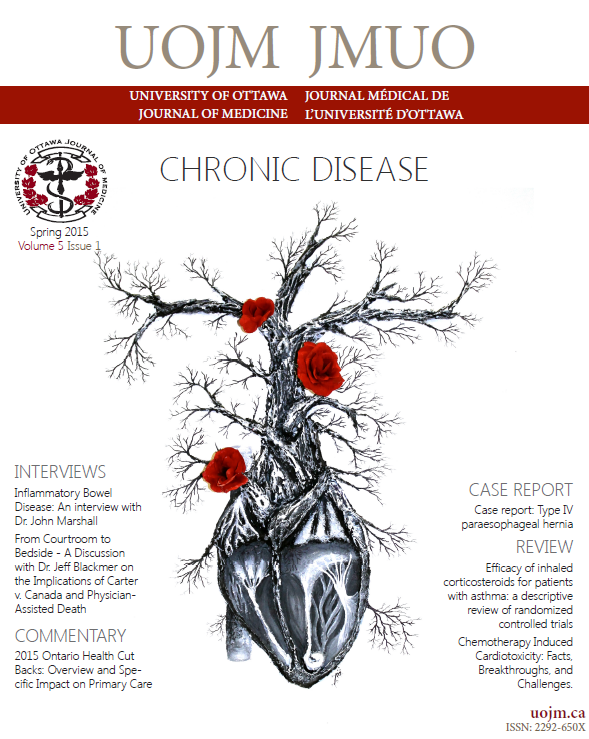Improving Chronic Kidney Disease Management using Wagner’s Model for Chronic Care
DOI:
https://doi.org/10.18192/uojm.v5i1.1213Abstract
The incidence of chronic disease is increasing as the population ages. Consequently, the Canadian health care system needs to implement systemic changes to manage chronic disease effectively. This paper applies the six basic elements for improving chronic care found in Wagner’s Chronic Care Model (CCM) to the management of chronic kidney disease. A fictional patient, Paul, is used to demonstrate the usefulness of this model in managing chronic diseases at a systemic and individual level.
References
1. Klostranec, JM, Kolin, DL, editors. Toronto Notes: A comprehensive medical reference & review for MCCQE I & USMLE II. 28th ed. Toronto, ON: Type & Graphics Inc; 2012. NP21-23 p.
2. Stevens, P. Models of Chronic Kidney Disease Care and Initiation of Dialysis. Presented at: Kent Kidney Care Centre, East Kent Hospitals, UK. PowerPoint presentation available from: http://www.kdigo.org/meetings_events/pdf/novel_tech/Paul%20Stevens.pdf
3. Barr, VJ, Robinson, S, Marin-Link, B, Underhill, L, Dotts, A, Ravensdale, D, et al. The Expanded Chronic Care Model: An Integration of Concepts and Strategies from Population Health Promotion and the Chronic Care Model. Hospital Quarterly 2003;7(1):73-83. http://dx.doi.org/10.12927/hcq.2003.16763
4. The Chronic Care Model [Internet]. Seattle: Improving Chronic Illness Care; c2006-2014 [cited 2014 May 11]. Available from: http://www.improvingchroniccare.org/index.php?p=The_Chronic_Care_Model&s=2
5. Improving Chronic Illness Care. Does the Chronic Care Model Work? Presented at: Group Health’s MacColl Institute. PowerPoint presentation available from: http://www.improvingchroniccare.org/downloads/2007_chronic_care_model.ppt
6. Narva, A, Briggs, M. The National Kidney Disease Education Program: improving understanding, detection, and management of CKD. American Journal of Kidney Diseases. 2009; 53(3) Supplement 3: S115-S120.
7. Ostbye, T, Yamall, KS, Krause, KM, Pollak, KI, Gradison, M, Michener, JL. Is there time for management of patients with chronic diseases in primary care? Ann Fam Med. 2005 May;3(3):209-214.
8. Poulos, RK, Antonsen, JE. Optimizing chronic kidney disease care: The primary-specialty care interface. BC Medical Journal 2005;47(6):300-304.
9. Levitt, C, Hilts, L. Quality Book of Tools. Hamilton: McMaster Innovation Press; 2010.
10. Victorian Government Department of Health. Promoting effective communication among healthcare professionals to improve patient safety and quality of care. Melbourne: Victorian Quality Council; 2010.
11. Renal PatientView [Internet]. NHS. [cited 2014 May 11]. Available from: https://www.patientview.org/index.do
2. Stevens, P. Models of Chronic Kidney Disease Care and Initiation of Dialysis. Presented at: Kent Kidney Care Centre, East Kent Hospitals, UK. PowerPoint presentation available from: http://www.kdigo.org/meetings_events/pdf/novel_tech/Paul%20Stevens.pdf
3. Barr, VJ, Robinson, S, Marin-Link, B, Underhill, L, Dotts, A, Ravensdale, D, et al. The Expanded Chronic Care Model: An Integration of Concepts and Strategies from Population Health Promotion and the Chronic Care Model. Hospital Quarterly 2003;7(1):73-83. http://dx.doi.org/10.12927/hcq.2003.16763
4. The Chronic Care Model [Internet]. Seattle: Improving Chronic Illness Care; c2006-2014 [cited 2014 May 11]. Available from: http://www.improvingchroniccare.org/index.php?p=The_Chronic_Care_Model&s=2
5. Improving Chronic Illness Care. Does the Chronic Care Model Work? Presented at: Group Health’s MacColl Institute. PowerPoint presentation available from: http://www.improvingchroniccare.org/downloads/2007_chronic_care_model.ppt
6. Narva, A, Briggs, M. The National Kidney Disease Education Program: improving understanding, detection, and management of CKD. American Journal of Kidney Diseases. 2009; 53(3) Supplement 3: S115-S120.
7. Ostbye, T, Yamall, KS, Krause, KM, Pollak, KI, Gradison, M, Michener, JL. Is there time for management of patients with chronic diseases in primary care? Ann Fam Med. 2005 May;3(3):209-214.
8. Poulos, RK, Antonsen, JE. Optimizing chronic kidney disease care: The primary-specialty care interface. BC Medical Journal 2005;47(6):300-304.
9. Levitt, C, Hilts, L. Quality Book of Tools. Hamilton: McMaster Innovation Press; 2010.
10. Victorian Government Department of Health. Promoting effective communication among healthcare professionals to improve patient safety and quality of care. Melbourne: Victorian Quality Council; 2010.
11. Renal PatientView [Internet]. NHS. [cited 2014 May 11]. Available from: https://www.patientview.org/index.do
Downloads
Published
2015-05-22
Issue
Section
Commentary
License
- Authors publishing in the UOJM retain copyright of their articles, including all the drafts and the final published version in the journal.
- While UOJM does not retain any rights to the articles submitted, by agreeing to publish in UOJM, authors are granting the journal right of first publication and distribution rights of their articles.
- Authors are free to submit their works to other publications, including journals, institutional repositories or books, with an acknowledgment of its initial publication in UOJM.
- Copies of UOJM are distributed both in print and online, and all materials will be publicly available online. The journal holds no legal responsibility as to how these materials will be used by the public.
- Please ensure that all authors, co-authors and investigators have read and agree to these terms.
- Works are licensed under a Creative Commons Attribution-NonCommercial-NoDerivatives 4.0 International License.


